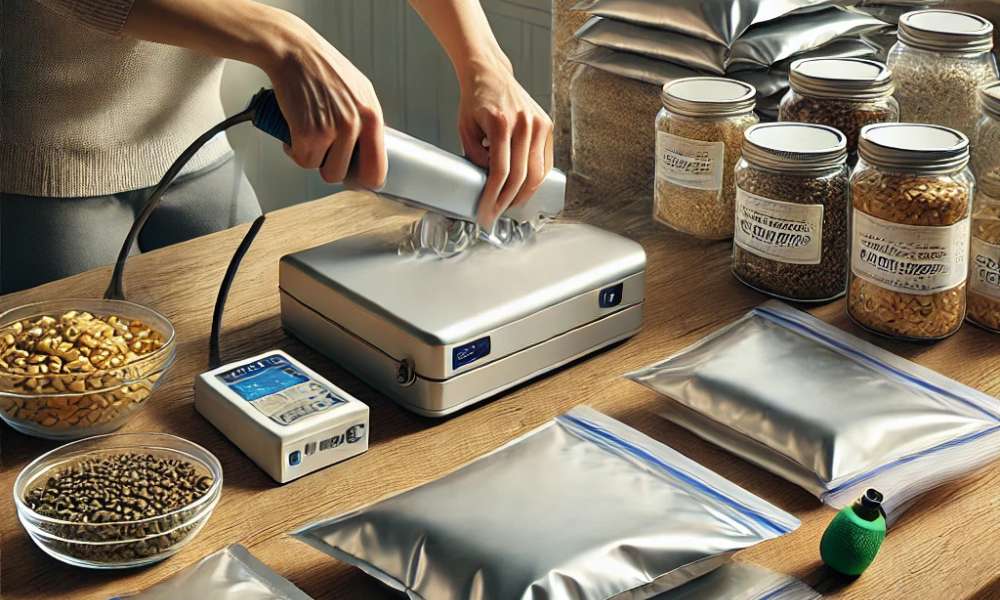Preserving food for the long haul has become an indispensable skill in an era marked by fluctuating economies and unpredictable supply chains. Among the plethora of storage options available, Mylar bags stand out as a revolutionary tool for safeguarding food against spoilage. These metallic-like bags are not just a product of advanced technology but a lifeline for anyone seeking long-term food security. In this guide, we will explore the remarkable utility of Mylar bags and the step-by-step process of using them effectively to store your food supplies.
What Are Mylar Bags?
Mylar bags are crafted from a type of stretched polyethylene terephthalate (PET), a material known for its unparalleled strength and resilience. Originally developed by NASA to protect spacecraft equipment, this innovation soon found its way into everyday applications. The silvery, reflective surface of Mylar isn’t just aesthetically striking; it acts as an impenetrable barrier against light, moisture, and air. This unique property makes Mylar the ideal candidate for food storage, especially for items that require preservation for years, if not decades.
Benefits of Using for Food Storage
The advantages of Mylar bags extend beyond their sturdy construction. First, their ability to block out light, which is a common catalyst for nutrient degradation, ensures that the stored food retains its original quality. Secondly, these bags create an oxygen-free environment when paired with oxygen absorbers, effectively halting microbial growth. Their compact design further allows you to store large quantities of food in minimal space, making them a boon for small apartments or emergency kits.
Essential Tools and Materials for Using Mylar Bags
Using these bags effectively requires a few essential tools:
- Mylar Bags: Available in various sizes, from small pouches for snacks to large bags for bulk grains.
- Oxygen Absorbers: These small packets absorb residual oxygen, ensuring an anaerobic environment inside the bag.
- Heat Sealer or Iron: Critical for creating an airtight seal, which is the linchpin of effective storage.
- Labels and Markers: Organization is key; clear labeling helps track storage dates and contents.
Step-by-Step Guide to Using Mylar Bags
1. Choose the Right Bag Size
Select bags based on the type and quantity of food you intend to store. Smaller pouches are suitable for portion-sized servings, while larger bags work well for bulk items like rice or wheat.
2. Prepare the Food for Storage
Dry the food thoroughly to eliminate any residual moisture, which can lead to spoilage. Foods like grains, legumes, and dehydrated fruits are excellent candidates for Mylar storage.
3. Insert Oxygen Absorbers
Place the recommended amount of oxygen absorbers into each bag. The quantity needed depends on the size of the bag and the type of food being stored.
4. Seal the Mylar Bag
Using a heat sealer or an iron on a high setting, seal the open end of the bag. Ensure that the seal is complete to prevent air from entering.
5. Label and Date the Bags
Mark each bag with the contents and storage date. This practice ensures efficient rotation and reduces the risk of overlooking older items.
Best Foods to Store in Mylar Bags
Certain food items benefit greatly from Mylar storage. Staples like rice, beans, oats, and pasta can last decades when stored correctly. Dried fruits, vegetables, and powdered items like flour or spices also fare well in this environment.
Foods to Avoid Storing
While Mylar pouches are versatile, they are not suitable for all foods. Items with high moisture or oil content, such as fresh produce or nuts, are prone to spoilage even in airtight conditions. Additionally, avoid storing foods with a short shelf life, as they may degrade despite optimal storage.
Storage Conditions
To maximize the lifespan of your stored food, keep these pouches in a cool, dry place. Avoid direct sunlight, which can compromise the integrity of the pouches. For added protection, consider placing the bags inside sturdy plastic bins or buckets.
How Long Does Food Last in Mylar Bags?
Under optimal conditions, food stored in these bags can last anywhere from 5 to 30 years. Factors such as the storage environment, quality of the seal, and use of oxygen absorbers play critical roles in determining longevity.
Troubleshooting Common Issues
- Leaks in the Bag: Check for small punctures or weak seals. Reseal the bag using a heat sealer.
- Improper Seals: Ensure even pressure and heat when sealing the bag.
- Spoiled Food: If the food appears discolored or emits an unusual odor, discard it to prevent contamination.
Advanced Tips
For an added layer of protection, consider vacuum sealing your Mylar pouches. This technique removes excess air before sealing, enhancing preservation. Additionally, portioning food into smaller pouches allows for easier access and prevents unnecessary exposure to air when retrieving stored items.
Sustainability and Reuse
Mylar pouches can often be reused if handled carefully. Clean them thoroughly and ensure no punctures before resealing. When they reach the end of their life cycle, consider recycling options to minimize waste.
Comparing Mylar Bags to Other Storage Methods
Compared to vacuum-sealed plastic pouches or mason jars, these bags offer superior longevity and versatility. While mason jars are great for shorter-term storage, they lack the compactness and durability of Mylar.
Conclusion
Mylar pouches are an indispensable tool for anyone serious about food preservation. Their ability to protect against environmental factors while maintaining food quality makes them a cornerstone of long-term storage strategies. Whether you’re preparing for emergencies or simply aiming to reduce waste, incorporating these bags into your storage routine is a step toward sustainability and security. Start using these pouches today and take control of your food storage needs.
